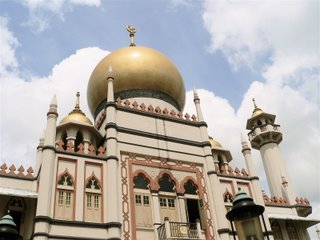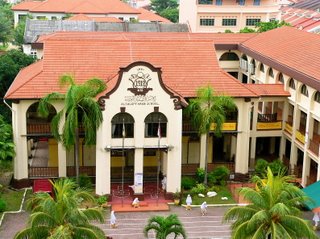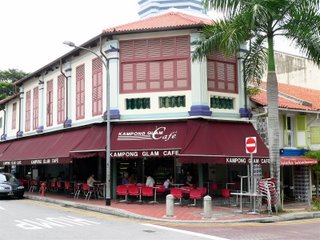Kampong Glam takes its name from the Gelam tree
(malaleuca leucadendron) that once grew in abundance in the area. Medicinal oil was extracted from Gelam tree while its bark was used by the Bugis and Malays to caulk the seams of their boats. Originally a fishing village at the mouth of the Rochor River, Kampong Glam was also the historic seat of Malay royalty in Singapore.
Yesterday, I took a jaunt to this historic area starting from the former Istana Kampong Glam (Istana means Palace in Malay) which now houses the Malay Heritage Centre (Taman Warisan Melayu).
 The Malay Heritage Centre.Click on the above photo for high-res image
The Malay Heritage Centre.Click on the above photo for high-res imageBuilt in 1840s as the palace of residence for the last Sultan of Singapore, Sultan Hussein Muaazzam Shah ibni Sultan Mahmud, this historical two-storey Palladian architecture-styled building was meticulously restored in 2003 to retain its flavour and authenticity. The Malay Heritage Museum now showcases the rich history and culture of Singapore’s Malay community.
 The Sultan Mosque (Masjid Sultan).Click on the above photo for high-res image
The Sultan Mosque (Masjid Sultan).Click on the above photo for high-res imageLocated at Muscat Street is the grand Masjid Sultan or Sultan Mosque crowned by its golden dome. It is the largest mosque in Singapore with the capacity to accommodate up to 5,000 Muslims in congregational prayers.
Originally built in 1824 by Sultan Hussein, the mosque features a massive golden dome and is one of Singapore’s most imposing religious institutions. The mosque is a blend of classical Turkish, Moorish and Persian style which brings out the magnificence of the era of colonial architecture.
 Bussorah Mall.Click on the above photo for high-res image
Bussorah Mall.Click on the above photo for high-res imageNo trip to Kampong Glam is ever complete without visiting Bussorah Mall, a pedestrian street of conserved shophouses which is closed to vehicular traffic. Fronting Sultan Mosque, Bussorah Mall cannot be missed. Tall graceful palm trees lined both sides of the street where the beautifully restored shophouses sell traditional clothes, artefacts, handicraft, furniture and jewelry.
 Haji Lane (The narrowest street in Singapore).Click on the above photo for high-res image
Haji Lane (The narrowest street in Singapore).Click on the above photo for high-res imageI made a little detour down a small lane halfway down Arab Street and found this quaint little street. It is barely the width of two cars ! Yes! This is the famous Haji Lane where the shophouses were all built in the pre-war era, and have now been conserved. Many of the old tenants and businesses in these shophouses are no longer around, although the architectural character has remained largely unaltered.
 The Alsagoff Arab School. Click on the above photo for high-res image
The Alsagoff Arab School. Click on the above photo for high-res imageBuilt in 1912, the school was named after Syed Ahmad Alsagoff, a wealthy merchant and philanthropist who was very influential in Singapore's early colonial days. It is the oldest girls' school in Singapore, and was the island's first Muslim school.
 Kampong Glam Cafe.Click on the above photo for high-res image
Kampong Glam Cafe.Click on the above photo for high-res imageFinally, I made a pit stop at this cafe along Baghdad Street where I had my "brekkie". I counted at least half a dozen Arabic cafes along Baghdad and Pahang Street serving Middle Eastern food and drinks. Baghdad Street is a favourite haunt of taxi drivers who stop by for Singapore's best
"teh tarik" (sweet tea with evaporated milk and sugar, served with a thick bubbly froth created by pouring the piping hot tea from a mug into a serving glass.)








No comments:
Post a Comment